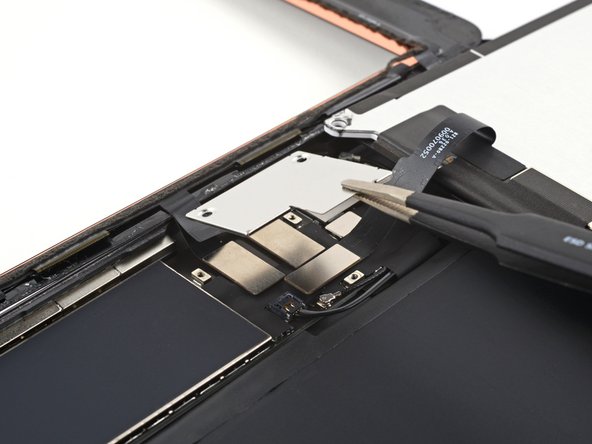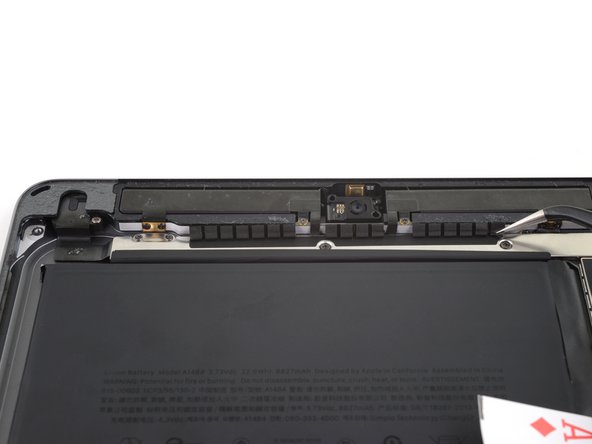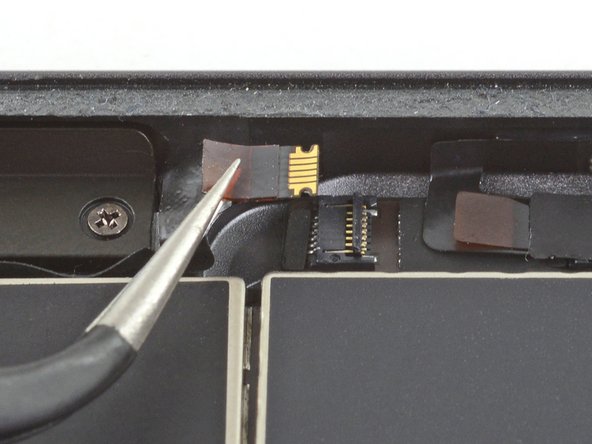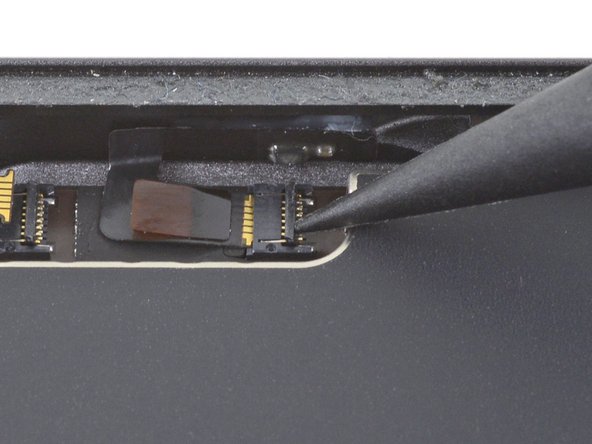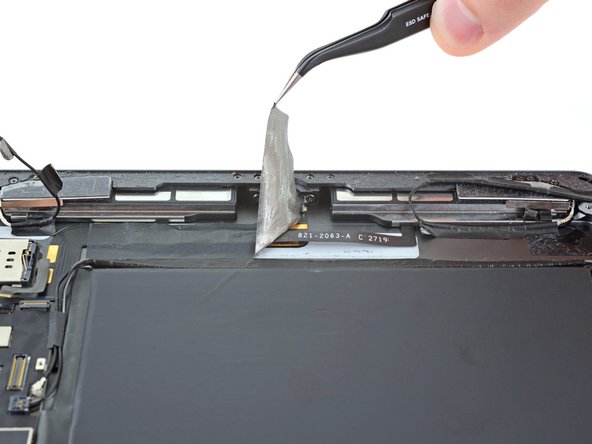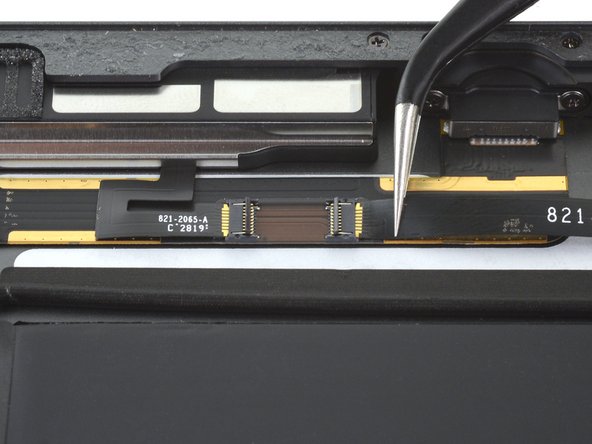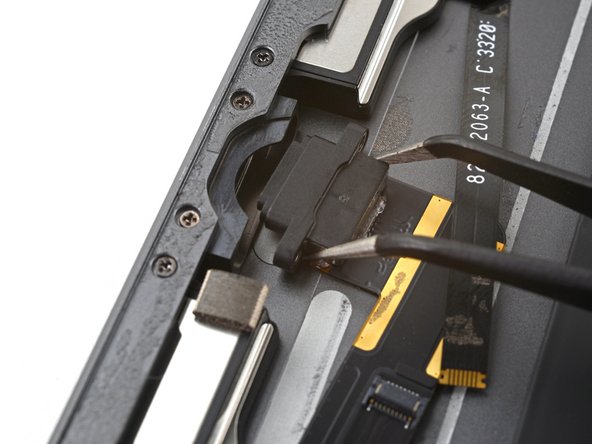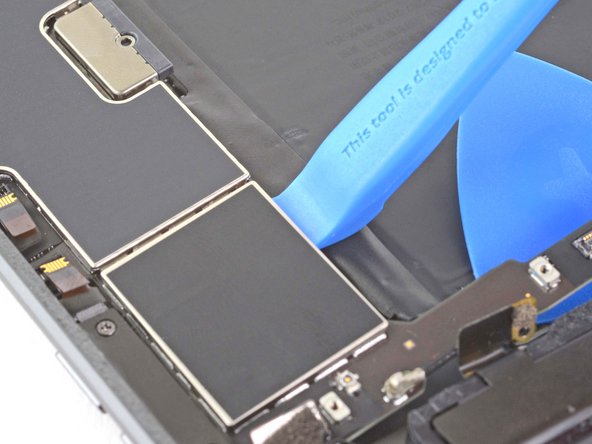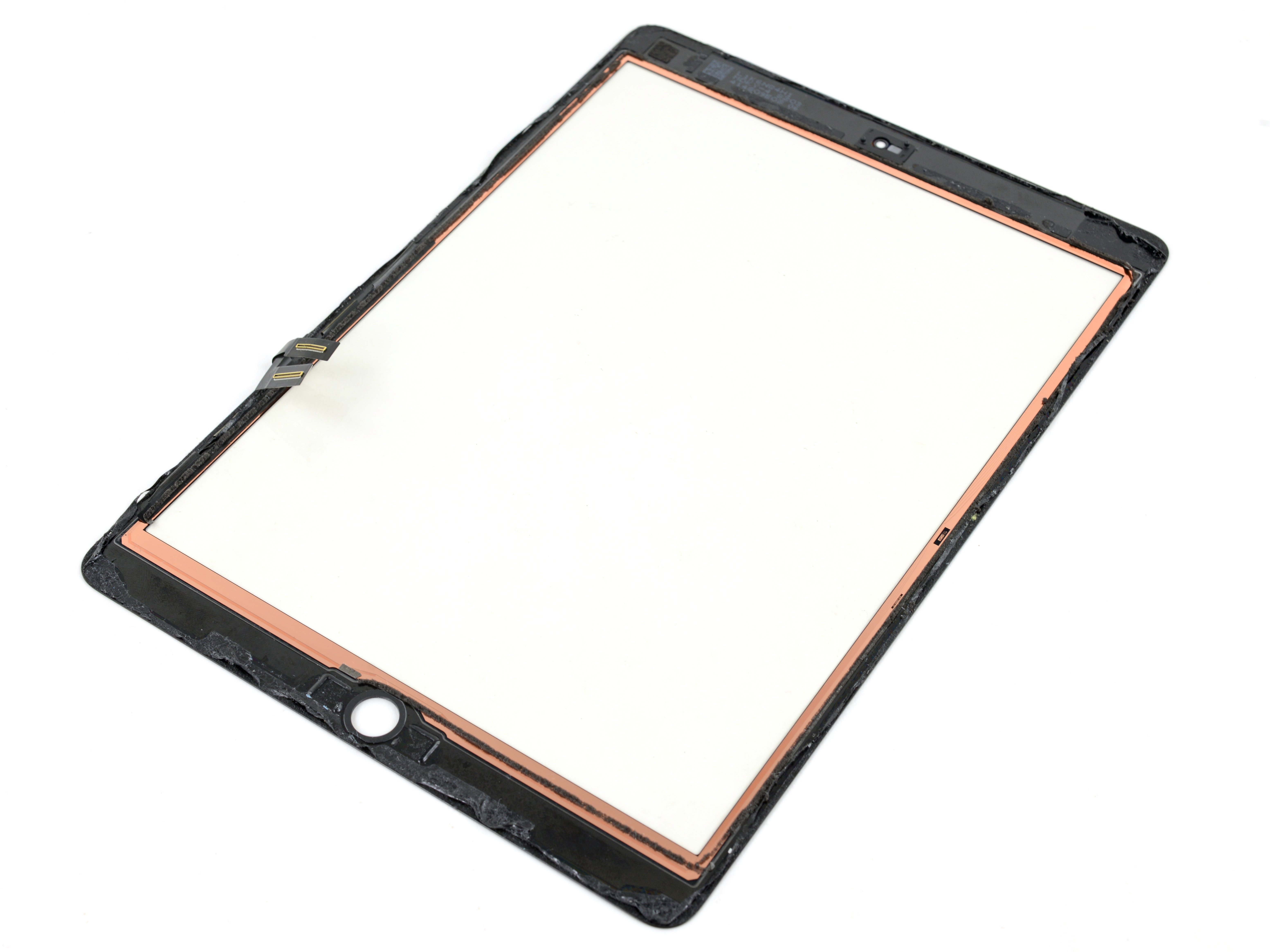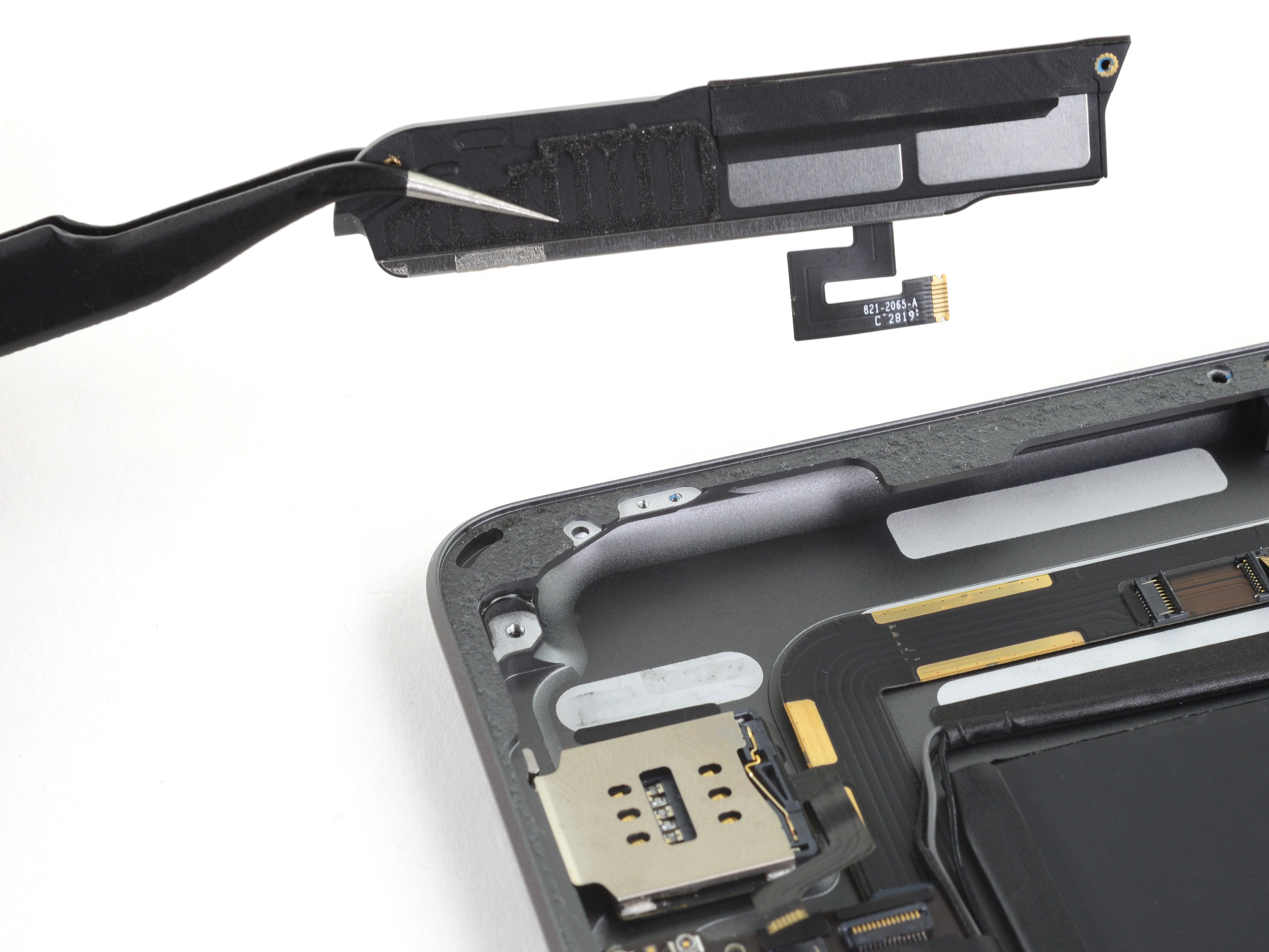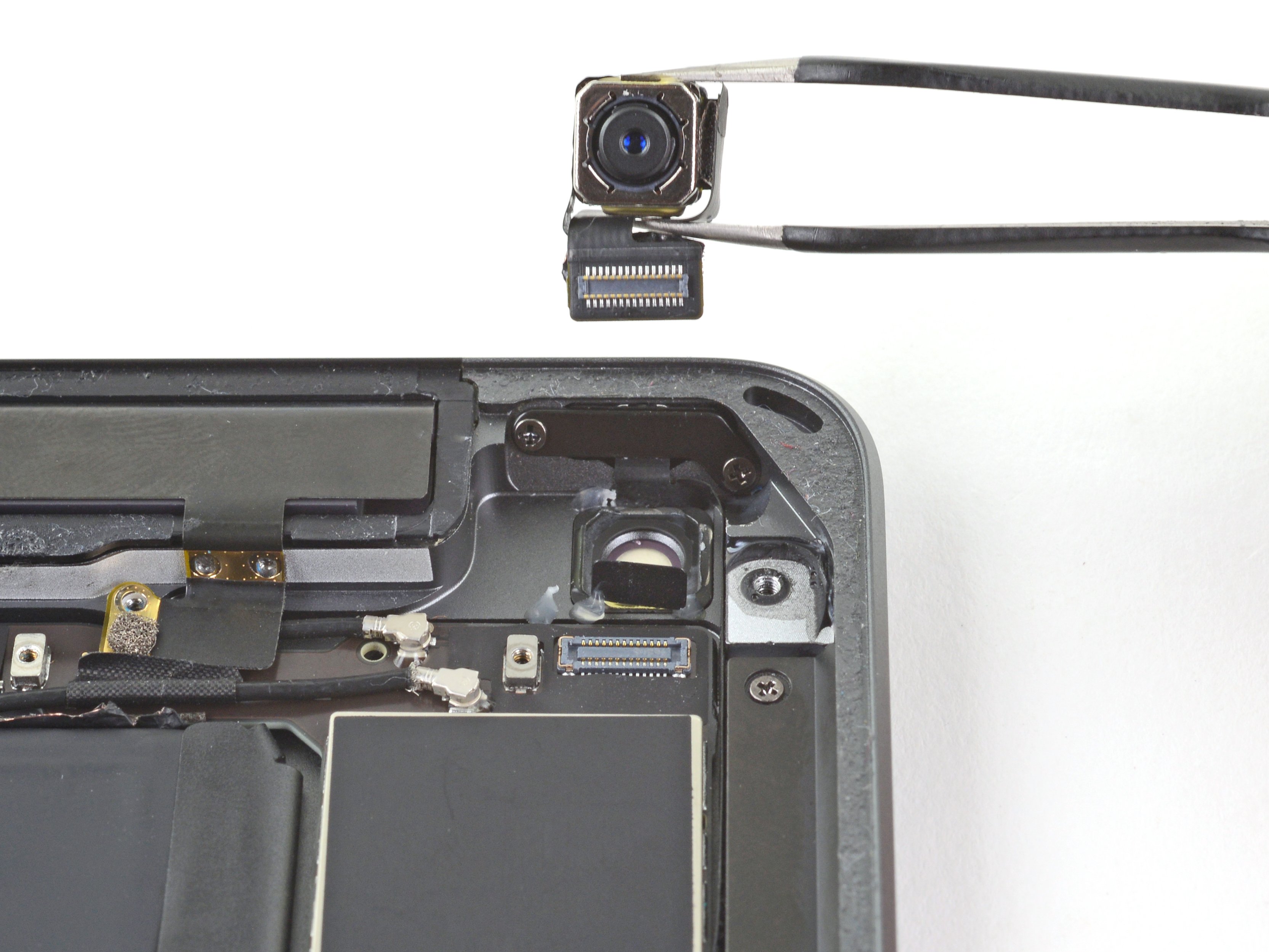iPad 8 LTE Logic Board Replacement
Duration: 45 minutes
Steps: 97 Steps
Follow this guide to swap out the logic board in your iPad 8 LTE model. Heads up: this walkthrough is only for the LTE version; for the Wi-Fi model, click here. When disconnecting the battery with a battery blocker, proceed with care—the battery contacts are fragile and can be damaged permanently. If you decide to skip isolating the battery, steer clear of metal tools unless absolutely necessary (like when unscrewing) to avoid short circuits and harming delicate components. Some images come from a different model and might look a bit different, but don’t worry—they won’t affect the steps you need to follow.
Step 1
- Warm up an iOpener and gently press it against the left edge of your device for two minutes. Let the heat do its thing and soften everything up for an easier repair!
Tools Used
Step 2
- As you let that adhesive do its thing, keep an eye out for these delicate spots that need a little extra care when prying:
- Front camera
- Antennas
- Display cables
Step 3
In the next three steps, we're going to show you how to use the Anti-Clamp, our nifty little gadget designed to make opening your device a breeze. If you don't have the Anti-Clamp handy, no worries! Just jump ahead three steps for a different approach.
Want to master the Anti-Clamp? Check out our guide for all the details!
If your iPad's surface feels a bit too slick for the Anti-Clamp to grip, a little tape can work wonders to give it a better hold.
- Slide the blue handle back to release the Anti-Clamp's arms.
- Set your iPad on something so it sits evenly between the suction cups.
- Place the suction cups close to the middle of the left edge—one near the top and one near the bottom.
- Keep the bottom of the Anti-Clamp steady while pressing down firmly on the top suction cup to create suction.
Step 4
- Grab the blue handle and pull it forward to lock those arms in place.
- Give the handle a full 360-degree clockwise spin, or keep turning until the suction cups start to stretch.
- Keep an eye on the suction cups — they should stay lined up. If they start to drift apart, loosen them a bit and realign the arms before moving on.
Step 5
Take it easy and don’t twist more than half a turn at once. Chill for a minute between each turn. Let the Anti-Clamp and some patience do their magic for you!
For a detailed walkthrough on how to wield that hair dryer like a pro, take a peek at this guide.
If the Anti-Clamp isn't quite making the magic happen, just crank up the heat a bit more and give that handle a cheerful half turn clockwise.
- Take a quick breather for about a minute to give the adhesive time to let go and create a little gap for you.
- If the screen's not heating up enough, a gentle hairdryer along the left edge of your iPad should do the trick.
- When the Anti-Clamp has created enough space, carefully slide an opening pick underneath the digitizer.
- Feel free to skip the next step.
Step 6
- When the screen feels warm to the touch, grab your suction handle and stick it right on the left edge of the screen, as close to the edge as you can get.
- Gently lift the screen using the suction handle to create a tiny gap between the digitizer and the frame.
- Slide an opening pick into the gap you've made between the digitizer and the frame.
If your display is badly cracked, try covering it with clear packing tape. This might help the suction cup stick better. If that doesn’t work, super strong tape can step in as a backup. And if you’re really in a pinch, a little superglue on the suction cup should do the trick to keep it attached to the broken screen. Just make sure you handle it carefully!
Tools Used
Step 7
No need to stress if you can see the opening pick peeking through the digitizer—just carefully pull it out. Your LCD screen should be just fine, but keep an eye out for any stubborn adhesive that might leave a little mess behind. No biggie though!
- Pop in a second opening pick right where you made your first move.
- Gently glide that pick towards the bottom-left corner of your device to break free from the sticky stuff holding it together.
- Keep that pick snug in the bottom-left corner so the adhesive doesn't decide to play a game of hide and seek!
Step 8
- If the opening pick gets stuck in the adhesive, try gently 'rolling' it along the side of the device to keep separating that sticky stuff. Patience is key!
Step 9
- Slide the first opening pick gently towards the top-left corner of your device to break that adhesive seal.
- Once you've got it in place at the top-left corner, leave the pick there to stop the adhesive from sticking back together.
Step 10
- Warm up that iOpener and give it a cozy hug to the top edge of your device for a solid two minutes.
Tools Used
Step 11
- Gently twist the pick around the top-left corner to loosen up that stubborn adhesive.
Step 12
Steer clear of sliding that pick over the front camera—it's a potential lens disaster waiting to happen! Follow these steps to keep it safe and sound.
- Gently slide the opening pick along the top edge of your device, making sure to pause right before you reach the front camera.
Step 13
- Gently pull the pick out so that just the tip stays wedged between the digitizer and the frame.
- Carefully slide the pick over the top of the front camera to loosen the adhesive.
- Keep the pick resting near the right side of the front camera before moving on to the next step.
Step 14
- Slip the pick back in and slide it up towards the top-right corner to fully break through that stubborn top adhesive.
- Keep the pick wedged in that corner so the adhesive doesn’t sneak back together on you.
Step 15
- Warm up an iOpener and stick it on the right edge of your device for a solid two minutes to loosen things up.
Tools Used
Step 16
- Gently rotate the pick around the top-right corner of your device to carefully separate the adhesive.
Step 17
The display cables hang out around the halfway mark from the bottom of your iPad. Slide along until you’re about three inches from the bottom, and then it’s time to stop!
- Grab a new opening pick and gently slide it to the center of the iPad's right edge. You've got this!
Step 18
- Heat up your iOpener and let it work its magic on the bottom edge of your device for about two minutes. Give it time to warm up so you can get to the next step with ease.
Tools Used
Step 19
Avoid spinning the pick all the way around the corner — the antenna's not a fan of wild moves!
- Gently slide that bottom-left pick right into the corner to break the adhesive free. You're doing great!
- Keep that pick in place before you move on to the next step. You've got this!
Step 20
Gently slide the pick towards the home button, not away from it – we don’t want any antenna mishaps!
If you find yourself needing to slide that pick over this area again, go ahead and take it out and pop it back in at the bottom-left corner. You've got this!
- Pop a new opening pick into the gap you just made along the bottom edge of the iPad.
- Gently slide the pick along, gliding over the antenna and stopping right before you reach the home button.
- Let the pick hang out to the left of the home button before moving on to the next step.
Step 21
Be gentle with that pick! Only slide it in about 1mm—any deeper and you might end up kissing the antenna. Keep it safe, keep it smooth!
- Gently slide your opening pick into the gap you just made—you're doing great so far!
- Now, carefully move the pick under the home button and glide it towards the bottom-right corner. Just make sure you're only slipping the tip between the digitizer and the frame. Take your time—precision is key!
Step 22
Just a friendly reminder: slide that pick toward the home button, not away! Going the wrong way could give the antenna a bit of a rough time.
If you're finding it tricky to slide the pick through this section, just take it out and re-insert it from the bottom-right corner. It’ll make everything a lot smoother!
- Pop the pick back in and slide it gently toward the home button to fully break the bottom adhesive free.
- Keep the pick near the right side of the home button before moving on to the next step.
Step 23
- Warm up an iOpener and let it chill on the right edge of your device for about two minutes.
Tools Used
Step 24
Take your time with this step—it's important! Make sure the adhesive is nice and toasty, and that you've got all of it separated with a pick. If you need to take a break and reheat, go for it! You've got this.
If you encounter some stubborn resistance, give the edges a little heat and gently glide your opening pick along them.
- Gently twist the two opening picks into the left corners of your iPad. This will lift the digitizer just enough to break the last of that stubborn adhesive. Keep it steady and easy—you're almost there!
Step 25
- Gently raise the left edge of the digitizer to help peel back the adhesive along the right edge of your iPad. You're doing great!
Step 26
- While holding the digitizer steady, gently slide an opening pick between the two display cables to break free the last bit of adhesive.
Step 27
- Once the adhesive is fully separated, gently open the digitizer like a book and lay it flat next to the iPad.
- When putting things back together, grab some isopropyl alcohol to clean off any leftover adhesive on both the frame and the digitizer (if you're keeping it). Then, just pop on some fresh adhesive using the pre-cut strips or adhesive cards.
- Be extra careful with those delicate display cables when reassembling. Make sure they’re tucked neatly under the LCD screen to avoid any mishaps.
Step 28
- Grab your trusty tweezers or just your fingers to peel away any tape that’s hiding those sneaky LCD screws.
Tools Used
Step 29
- Grab your trusty Phillips screwdriver and take out the four 4.3 mm screws holding the LCD screen in place.
Step 30
The LCD is gently stuck to the frame.
- Gently slide a spudger into the gap between the frame and the top-right corner of the LCD.
- Carefully pry with the spudger to break loose that stubborn adhesive.
Tools Used
Step 31
- Do the same thing for the top-left corner of the LCD—easy does it!
Step 32
Hold off on yanking the LCD out just yet — it’s still hanging on by a flex cable!
- Grab your trusty spudger and gently nudge the LCD out of its cozy little spot just enough so you can get a grip on it with your fingers.
- Now, flip that LCD like a page in a book, lifting it up near the camera and swinging it over towards the home button side of the frame.
- Place the LCD down on a clean, soft, lint-free surface to give those display cables some breathing room.
Tools Used
Step 33
- Grab your trusty Phillips screwdriver and loosen up that 2.3 mm-long screw that's holding the battery connector tight to the logic board. You've got this!
Step 34
Check out these pics to see what the battery connector looks like tucked under the logic board. Keep them handy as you carefully unplug the battery.
Heads up: the battery connector uses cantilever springs on the logic board that press against the battery’s contact pads. Since both the logic board and battery are glued down, you’ll want to slide something thin and flexible between those contacts to safely disconnect the battery.
Step 35
Heads up when using a battery blocker to isolate the battery—those battery contacts are super easy to bend or snap, and once that happens, it’s game over. Handle with care!
Make sure the iFixit logo on the battery blocker is facing up like a proud banner!
Be gentle with the battery blocker—no need to muscle it in there! If it's being stubborn, try using a playing card to gracefully disconnect the battery instead.
The battery blocker or playing card should smoothly slide under the logic board, avoiding any hurdles. Once it's in, it should chill at about a 15-degree angle, looking cool as a cucumber.
- Gently slide the battery blocker under the logic board's battery connector at a cool 35-degree tilt.
- Keep that battery blocker snugly in place while you tackle the rest of the repair.
Tools Used
Step 36
- Grab your Phillips screwdriver and unscrew the three tiny 1.4 mm screws holding down the display cable bracket. Keep those screws safe!
Step 37
- Gently use tweezers or your fingers to lift and remove the display cable bracket.
Tools Used
Step 38
- Grab the flat end of your spudger and gently lift to disconnect the LCD cable press connector. Be careful, no need to rush here.
- When it’s time to re-attach those press connectors, take it slow. Align one side carefully, press down until it clicks, then move to the other side and do the same.
- Avoid pressing the middle. If the connector isn’t lined up right, you might end up bending the pins. That’s a permanent oops.
Tools Used
Step 39
- Carefully take out the LCD and place it face down on a clean, soft, lint-free surface. Treat it like the precious gem it is!
Step 40
- Grab a pair of tweezers and gently lift the tape covering the home button cable ZIF connector.
Tools Used
Step 41
- Grab a spudger, an opening tool, or even your fingernail, and gently flip up the tiny hinged locking flap on the home button cable ZIF connector. Easy does it!
Tools Used
Step 42
- Grab a pair of tweezers and carefully pull the home button ribbon cable out of the ZIF connector. Take it slow and steady – no need to rush here!
Tools Used
Step 43
To keep your iPad safe and sound, make sure to pry gently on the connectors themselves, not the socket on the logic board. You've got this!
- Gently wedge the flat end of a spudger under the two digitizer cable press connectors to pop them loose and disconnect them.
Tools Used
Step 44
Watch out for the home button ribbon cable—it's delicate, so avoid poking or tearing it!
- Grab your spudger and use the flat end to gently lift the vibration isolator sitting just below the SIM card reader.
- Now, go ahead and remove the vibration isolator.
Tools Used
Step 45
The cable is gently held in place with a bit of light adhesive.
- Grab a pair of tweezers and gently lift the home button cable away from the rear case. Take your time and be gentle with it—this part is like peeling the skin off a ripe fruit, so don’t rush!
Tools Used
Step 46
Grab an opening pick and carefully slice through any leftover adhesive still holding the front panel assembly to the frame.
Without proper insulation, parts of the digitizer might short out against other components, messing with touch functionality.
This insulation is tiny and invisible to the eye, different from the foam dust barrier strips you might find on many iPads.
- Let's kick things off by removing the front panel assembly. Easy peasy!
- Are you dealing with those pesky 'ghost' or 'phantom' touch issues on your shiny new display? No worries! Just grab some ultra-thin insulating tape, like Kapton (polyimide) tape, and apply it to the highlighted areas on the back of the panel. But hey, if you got a replacement digitizer from us, you're all set! It comes with the right insulation, so no extra tape needed.
- Now, as we get ready to piece it all back together, make sure to clear away any leftover adhesive from the iPad. Give those glued areas a good cleaning with some high-concentration isopropyl alcohol (90% or greater) and a lint-free cloth. This little prep step is crucial for making sure your fresh adhesive sticks like a champ!
- Finally, it's time to test out your iPad's awesome functions! Once you're happy, apply those pre-cut adhesive strips to the back of the display using our display adhesive application guide, and then seal it all up. If you find yourself needing help at any point, don’t hesitate to schedule a repair!
Step 47
- Grab your trusty SIM eject tool, a bit, or even a straightened paper clip and gently insert it into the SIM card tray hole.
- Give it a firm push to pop that SIM card tray out like a champ!
Step 48
- Pop out the SIM card tray from your iPad, like a pro!
Step 49
- Gently lift the LCD buffer tape off the upper component bracket, taking care to keep things neat and tidy.
Step 50
- Grab your Phillips screwdriver and take out the five screws holding down the upper component bracket:
- Three screws, each 1.4 mm long
- Two screws, each 1.9 mm long
Step 51
You might need to carefully peel off the upper component bracket if it’s stuck down with some tape holding it to the logic board.
- Gently pry up the upper component bracket using the pointed tip of your spudger until you can pinch it between your fingers.
- Take the upper component bracket off and set it aside.
Tools Used
Step 52
- Grab the flat end of your trusty spudger and gently nudge up to disconnect that front camera cable press connector. You've got this!
Tools Used
Step 53
- Grab your trusty spudger and gently lift the front camera out of its cozy little home until you can give it a friendly grip with your fingers.
- Now, use that spudger to carefully peel away the adhesive foam pad that's been keeping the front camera snug and secure.
Tools Used
Step 54
- Grab your trusty tweezers and gently hold onto the front camera. Give it a little twist to the right—like you're threading a needle! This will help the cable find its cozy spot in the frame.
- Now, it's time to say goodbye to the front camera and carefully remove it.
Tools Used
Step 55
- Grab the flat end of your trusty spudger and gently pry up the headphone jack connector—lift it straight up like you mean it, but keep it cool!
Tools Used
Step 56
- Grab a trusty pair of tweezers and gently lift the headphone jack away from the logic board, then give that cable a little nudge to reposition it just right. You've got this!
Tools Used
Step 57
- Grab your Phillips screwdriver and carefully take out the three 1.4 mm screws holding the cellular antennas to the back case. Keep them safe for reassembly!
Step 58
- Grab your spudger and use its pointed end to carefully detach the right cellular antenna cable. Get as close to the connector as possible for a clean disconnect.
- Now, do the same for the left antenna cable—easy does it, just give it a gentle pry.
Tools Used
Step 59
Handle the antenna cable by the cable itself, not the connector. Tugging on the connector can cause some serious damage. Treat it with care, and everything will stay in one piece.
- Gently peel the left cellular antenna coaxial cable away from the rear case, just like peeling a sticker off your favorite book. No rush, just a smooth move.
Step 60
- Grab your trusty spudger and use the flat end to gently lift both cellular antennas straight up from their press connectors. Simple, right?
Tools Used
Step 61
- Grab the flat end of your trusty spudger and gently lift the rear camera's press connector straight up to unplug it—easy does it!
Tools Used
Step 62
- Grab your trusty spudger and gently lift the microphone assembly straight up from the press connector. You've got this!
Tools Used
Step 63
- Gently peel back any tape covering the button control cable ZIF connector.
Step 64
- Gently nudge the little hinged locking flap on the button control cable ZIF connector upwards using the tip of a spudger, an opening tool, or even your trusty fingernail. You've got this!
Tools Used
Step 65
Hold onto the cable using the pull tab—resist the urge to tug on the cable itself!
- Grab your tweezers and gently wiggle the button control cable straight out from the ZIF connector—steady hands win the day!
Tools Used
Step 66
- Gently remove any tape that might be blocking the Smart Cover sensor cable ZIF connector.
Step 67
- Gently use a spudger, an opening tool, or your trusty fingernail to lift the small hinged flap on the Smart Cover sensor cable ZIF connector. Take your time, no rush!
Tools Used
Step 68
Hold onto the cable using the pull tab, not the cable itself. You've got this!
- Gently grab your trusty tweezers and carefully wiggle the Smart Cover sensor cable out of the ZIF connector. Keep it steady and straight—you're doing great!
Tools Used
Step 69
- Gently pry up the tiny, hinged locking flap on the SIM card reader cable ZIF connector using the tip of a spudger, an opening tool, or even your trusty fingernail. You've got this!
Tools Used
Step 70
- Grab your trusty tweezers and gently wiggle that SIM card reader cable out of the ZIF connector like you're delicately plucking a flower from a garden.
Tools Used
Step 71
- Slide the sharp end of your spudger gently under the right antenna cable and give it a straight-up lift to unplug it.
Tools Used
Step 72
Grab the antenna cable by the cable itself, not by the connector. Tugging on the connector can cause it to break. Treat it like it’s fragile, and you’ll be good to go!
- Gently lift the right antenna cable upward.
Step 73
- Slide the pointy tip of a spudger underneath the left antenna cable and gently lift straight up to unplug it.
Tools Used
Step 74
- Gently lift the left antenna cable off the rear case, sliding it along the bottom edge of the iPad like a pro.
Step 76
- Grab a pair of tweezers or just use your trusty fingernail to gently lift up the tape that's covering those sneaky speaker connectors.
Tools Used
Step 77
- Grab your trusty spudger, an opening tool, or even your fingernail, and gently lift the small, hinged locking flaps on both the left and right speaker cable ZIF connectors. You've got this!
Tools Used
Step 78
- Grab your tweezers and gently wiggle the left and right speaker cables straight out of their ZIF connectors—nice and easy, no sudden moves!
Tools Used
Step 79
- Grab the pointy end of your trusty spudger and gently pry up the Smart Connector coaxial cable, aiming to lift it right at the connector for a smooth disconnect.
Tools Used
Step 80
- Grab your tweezers and gently lift the Smart Connector cable connector straight up to unplug it. Easy does it!
Tools Used
Step 81
- Grab a trusty pair of tweezers and gently peel back the tape that's holding those Smart Connector cables in place on the rear case. You've got this!
Tools Used
Step 82
- Gently lift the Smart Connector cables away from the back case, taking care not to tug too hard!
Step 83
- Warm up an iOpener and place it on the bottom left corner of the back case for about thirty seconds to loosen up the SIM card tray's adhesive.
Tools Used
Step 84
If the SIM card reader seems a bit stubborn, warm it up a little more and give it another go!
- Gently nudge the bottom edge of the SIM card reader with your trusty opening tool, using a slow and steady force to lift it up. You've got this!
Step 85
- Carefully pop out the SIM card reader to keep things moving!
Step 86
- Grab your trusty Phillips screwdriver and loosen the four screws holding the charging port in place on the frame:
- Two screws measuring 2.2 mm in length
- Two screws measuring 3.2 mm in length
Step 87
- Warm up an iOpener and place it on the bottom, top, and logic board side of the iPad, holding it there for about thirty seconds each spot to loosen things up.
Tools Used
Step 88
- Slide an opening pick beneath the charging port cable close to the charging port and gently glide it towards the logic board to break the adhesive seal.
Step 89
- Gently wiggle the charging port free from its snug little home in the frame.
Step 90
- Slide an opening pick under the upper arm of the logic board and gently glide it along to slice through the adhesive that’s holding it to the rear case. You got this!
- Keep that opening pick in place to prevent the adhesive from sticking back. You're on the right track!
Step 92
Twisting or bending the logic board is a no-go—it could cause some serious, permanent damage. If that stubborn adhesive isn’t budging, just add a little more heat and give it another go.
Carefully slide an opening pick under the bottom edge of the logic board to gently cut through some of the sticky adhesive if the board is being stubborn.
- Slide your opening tool in near the bottom of the logic board and gently pry it up with a slow, steady motion to separate it from the rear case.
Step 93
Be cautious when using your tool near the battery—if you poke or bend it, you might release some nasty chemicals or even spark a fire. Safety first, friends!
- Grab your opening tool and gently slide it near the center of the logic board. Apply a little steady pressure to lift it away from the rear case. Take your time – slow and smooth wins the race!
Step 94
- Gently slide an opening tool in near the top of the logic board, and with a steady hand, pry it up to gracefully separate it from the rear case. You're doing great!
Step 95
- Gently slide an opening tool into the middle of the logic board, then carefully pry it up until you can grab it with your fingers. Easy does it!
Step 96
- Grab your trusty halberd spudger or an opening pick and gently slice through any leftover adhesive that’s keeping the logic board snugly attached to the frame. You've got this!
Tools Used
Step 97
- Now, just put everything back together in reverse and you're all set!
- Got some old tech? Make sure to recycle it properly by taking it to an R2 or e-Stewards certified recycler.
- Something went wrong? No worries! Try some basic troubleshooting, or get some help from our community on iPad 8 Answers.
- If you're feeling stuck, you can always schedule a repair.
































































































